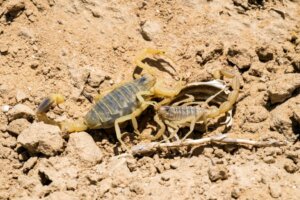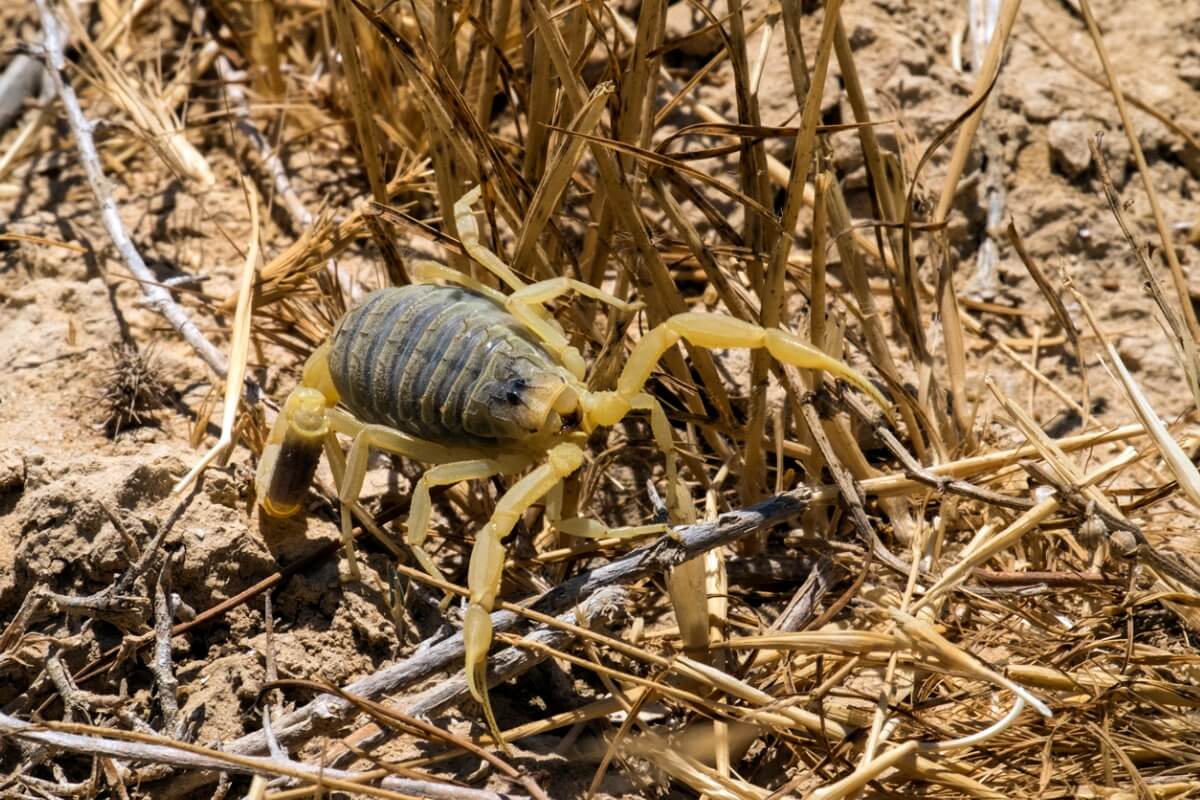Palestinian Yellow Scorpion: One of the Most Poisonous in the World


Written and verified by the biologist Cesar Paul Gonzalez Gonzalez
Scorpions are some of the oldest poisonous animals around. The ancestors of these invertebrates inhabited the Earth for 350 million years and they have now given rise to more than 2,500 species. Specifically, the Palestinian yellow scorpion (Leiurus quinquestriatus) is one of the most poisonous in the world.
Scorpions have specialized in hunting insects and other small living beings, but some of them even dare to face vertebrates. If you want to know more about this topic, keep reading.
Scorpions and their venom
It may seem strange at first glance, but in reality these types of animals are more related to spiders than to any insect. In other words, both common spiders such as tarantulas and scorpions are arachnids. Specifically, scorpions prefer tropical environments and occupy habitats such as forests, savannas, and deserts.
Scorpions can be found almost anywhere in the world. However, they’re more common in arid or jungle ecosystems than in areas near the poles. These animals go hunting at night and feed on other insects, lizards or rodents. Its main natural enemies are birds.
In the world, almost 1,200,000 scorpion sting accidents are registered annually, as indicated by the Mayo Clinic. However, only 30 of the 1,500 toxic species within this group can be lethal to humans.
The venom that these arachnids inject may contain some neurotoxic components, which allows them to paralyze their victim. In addition, many of these toxins are of medical importance, because they affect the cardiovascular and pulmonary systems of the human body. As you can imagine, this can lead to a fatal outcome.

The yellow Palestinian scorpion
This invertebrate comes from the Sahara desert, but has managed to move to the Mediterranean region. It’s a fairly long arachnid, as it can reach 110 millimeters in length. In addition, it lives under rocks or channels dug by itself in desert areas.
Physically speaking, this scorpion is yellow, with horizontal gray stripes all over the body. On its tail you can see a dark part that contrasts with the rest of the organism. This feature can aid identification, but it isn’t a 100% reliable feature.
Dangerous distribution
This species is restricted to Sudan and Egypt. Even so, similar animals have been found in different regions of North Africa. These sightings were previously believed to correspond to the Palestinian yellow scorpion, however scientists have classified these citations as 12 different populations.
There are still several questions about this scorpion, but what’s evident is that it continues to move to other areas. Cases have even been reported where specimens are found living inside homes, something that was rare before.
Scorpion dance
For their reproduction, these animals behave in the most romantic way possible. They take their partner by their tongs and begin to dance, as if it were a waltz. If the female accepts the courtship, the male produces a capsule with his sperm in it and mates her.
On average, the gestation of the young takes place in 158 days and the female gives birth to over 60 small scorpions. Many of them will die in the first days of life, due to the characteristic intraspecific cannibalism in arachnids.
A quick and fatal poison
Unfortunately, a scorpion’s danger can’t be measured by its color. This animal, in addition to having one of the most dangerous poisons in the world, also has the record of being one of the fastest to bite. It’s capable of moving at nearly 130 centimeters per second, quite fast compared to other scorpions.
The venom of this species is capable of causing damage to the cardiovascular and respiratory system, as indicated by the professional journal Toxicon. Because of this, this scorpion is particularly dangerous for young children and infants, as the toxins affect people lighter people more.
Although it can be dangerous, the poison also opens up the opportunity to be used as a remedy for other diseases. The properties of these toxins are still under study, but it’s believed that those of some species could actually shrink tumors in cancer patients, according to recent research.
Not everything is bad when it comes to poisons.

What, at first sight, seems dangerous isn’t always bad for humanity. On the contrary, the poisons present in some living beings give us the opportunity to see new uses that benefit our health. In the end, we have to remember that we coexist with many species and we need to learn to live with them, not to eradicate them.
Scorpions are some of the oldest poisonous animals around. The ancestors of these invertebrates inhabited the Earth for 350 million years and they have now given rise to more than 2,500 species. Specifically, the Palestinian yellow scorpion (Leiurus quinquestriatus) is one of the most poisonous in the world.
Scorpions have specialized in hunting insects and other small living beings, but some of them even dare to face vertebrates. If you want to know more about this topic, keep reading.
Scorpions and their venom
It may seem strange at first glance, but in reality these types of animals are more related to spiders than to any insect. In other words, both common spiders such as tarantulas and scorpions are arachnids. Specifically, scorpions prefer tropical environments and occupy habitats such as forests, savannas, and deserts.
Scorpions can be found almost anywhere in the world. However, they’re more common in arid or jungle ecosystems than in areas near the poles. These animals go hunting at night and feed on other insects, lizards or rodents. Its main natural enemies are birds.
In the world, almost 1,200,000 scorpion sting accidents are registered annually, as indicated by the Mayo Clinic. However, only 30 of the 1,500 toxic species within this group can be lethal to humans.
The venom that these arachnids inject may contain some neurotoxic components, which allows them to paralyze their victim. In addition, many of these toxins are of medical importance, because they affect the cardiovascular and pulmonary systems of the human body. As you can imagine, this can lead to a fatal outcome.

The yellow Palestinian scorpion
This invertebrate comes from the Sahara desert, but has managed to move to the Mediterranean region. It’s a fairly long arachnid, as it can reach 110 millimeters in length. In addition, it lives under rocks or channels dug by itself in desert areas.
Physically speaking, this scorpion is yellow, with horizontal gray stripes all over the body. On its tail you can see a dark part that contrasts with the rest of the organism. This feature can aid identification, but it isn’t a 100% reliable feature.
Dangerous distribution
This species is restricted to Sudan and Egypt. Even so, similar animals have been found in different regions of North Africa. These sightings were previously believed to correspond to the Palestinian yellow scorpion, however scientists have classified these citations as 12 different populations.
There are still several questions about this scorpion, but what’s evident is that it continues to move to other areas. Cases have even been reported where specimens are found living inside homes, something that was rare before.
Scorpion dance
For their reproduction, these animals behave in the most romantic way possible. They take their partner by their tongs and begin to dance, as if it were a waltz. If the female accepts the courtship, the male produces a capsule with his sperm in it and mates her.
On average, the gestation of the young takes place in 158 days and the female gives birth to over 60 small scorpions. Many of them will die in the first days of life, due to the characteristic intraspecific cannibalism in arachnids.
A quick and fatal poison
Unfortunately, a scorpion’s danger can’t be measured by its color. This animal, in addition to having one of the most dangerous poisons in the world, also has the record of being one of the fastest to bite. It’s capable of moving at nearly 130 centimeters per second, quite fast compared to other scorpions.
The venom of this species is capable of causing damage to the cardiovascular and respiratory system, as indicated by the professional journal Toxicon. Because of this, this scorpion is particularly dangerous for young children and infants, as the toxins affect people lighter people more.
Although it can be dangerous, the poison also opens up the opportunity to be used as a remedy for other diseases. The properties of these toxins are still under study, but it’s believed that those of some species could actually shrink tumors in cancer patients, according to recent research.
Not everything is bad when it comes to poisons.

What, at first sight, seems dangerous isn’t always bad for humanity. On the contrary, the poisons present in some living beings give us the opportunity to see new uses that benefit our health. In the end, we have to remember that we coexist with many species and we need to learn to live with them, not to eradicate them.
All cited sources were thoroughly reviewed by our team to ensure their quality, reliability, currency, and validity. The bibliography of this article was considered reliable and of academic or scientific accuracy.
- De Roodt, A. R. (2015). Veneno de escorpiones (alacranes) y envenenamiento. Acta bioquímica clínica latinoamericana, 49(1), 55-71.
- Córdoba, M. M. S., & Patiño, R. O. (2000). Los escorpiones: aspectos ecológicos, biológicos y toxinológicos. Medunab, 3(7), 17-23.
- Sarhan, M., Badry, A., Younes, M., & Saleh, M. (2020). Genetic diversity within Leiurus quinquestriatus (Scorpiones: Buthidae) populations in Egypt as inferred from 16S mDNA sequence analysis. Zoology in the Middle East, 66(3), 269-276.
- Ross, LK. (2009). Notes on gestation periods and litter size in the arenicolous buthid scorpion Leiurus quinquestriatus (Ehrenberg, 1828) (Scorpiones: Buthidae). Journal of Venomous Animals and Toxins including Tropical Diseases, 15(2), 347-352. https://doi.org/10.1590/S1678-91992009000200015
- Mohamed A. A. Omran & Alistair McVean (2000) INTRASPECIFIC VARIATION IN SCORPION LEIURUS QUINQUESTRIATUS VENOM COLLECTED FROM EGYPT (SINAI AND ASWAN DESERTS), Journal of Toxicology: Toxin Reviews, 19:3-4, 247-264, DOI: 10.1081/TXR-100102322
- Al-Shanawani, A. R., Fatani, A. J., & El-Sayed, F. H.. (2005). The effects of a sodium and a calcium channel blocker on lethality of mice injected with the yellow scorpion (Leiurus quinquestriatus) venom. Journal of Venomous Animals and Toxins including Tropical Diseases, 11(2), 175-197. https://doi.org/10.1590/S1678-91992005000200008
- Coelho, P., Kaliontzopoulou, A., Rasko, M., & van der Meijden, A. (2017). A ‘striking’relationship: scorpion defensive behaviour and its relation to morphology and performance. Functional Ecology, 31(7), 1390-1404.
- PERETTI, A. V., ACOSTA, L. E., & BENTON, T. G. (1999). Sexual cannibalism in scorpions: fact or fiction?. Biological Journal of the Linnean Society, 68(4), 485-496.
- Habib, T. N., Hassan, H. A., Ali, F. M., & Mahrous, N. S. (2019). Evaluation of Leiurus quinquestriatus scorpion venom anticancer potential against Prostate Cancer Cell Lines (PC3). Journal of Environmental Studies [JES], 19, 7-13.
- Goyffon, M. (2002). Scorpion stings in sub-Saharan Africa. Bulletin de la Societe de pathologie exotique (1990), 95(3), 191-193.
- D’Suze, G., Rosales, A., Salazar, V., & Sevcik, C. (2010). Apoptogenic peptides from Tityus discrepans scorpion venom acting against the SKBR3 breast cancer cell line. Toxicon, 56(8), 1497-1505.
This text is provided for informational purposes only and does not replace consultation with a professional. If in doubt, consult your specialist.








